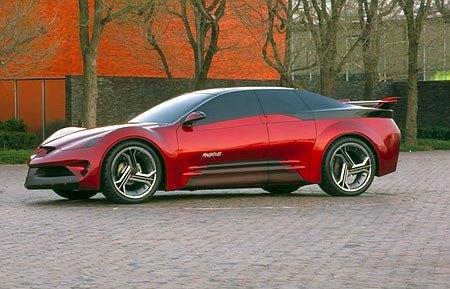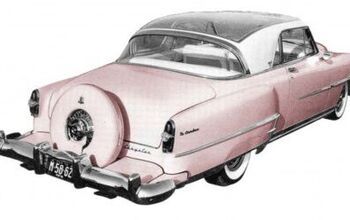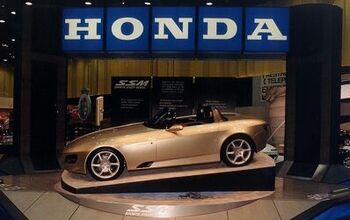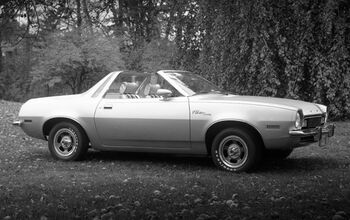The Encyclopedia of Obscure Concept and Show Cars: Part Five – Pontiac to Volvo

1998 Pontiac Rageous
All good things, even obscure and maybe even not so good, must come to an end. You can see previous installments of the Encyclopedia of Obscure Concept and Show Cars here, here, here, and here.
Oldsmobile, Packard, Plymouth. Another dead brand with obscure concept cars in this part of the alphabet is Pontiac. This is their Rageous concept from 1997, another proto-CUV, and what some have called “the Aztek that should have been”. Imagine a four door Trans Am (the rear doors are suicide style like on the RX-8 Mazda) with a hatchback and a flat load floor that will accommodate a 4X8 sheet of plywood. A ’90s vintage LT1 and a Corvette based rear suspension completed the package, which of course had Pontiac’s supernumerary nostrils from that era. Actually, the Rageous isn’t that obscure. Mattel’s Hot Wheels released their own version of it in 1999 and reissued it at least 8 times since then. Like the Jeep Jeepster concept, if you’re a Gen Y’er, or a baby boomer who collects Hot Wheels you may actually remember the Pontiac Rageous.
Speak of the devil. Not a bad idea, but much better in theory than in practice.
The name Banshee has graced a number of sporty Pontiac show cars starting in 1964. You can see how GM designers were trying to come up with an integrated rear spoiler and this 1988 Banshee did have an influence on the Firebird and Camaro but I think the 4th generation Camaro, which came out in 1993, had an even better integrated spoiler.
In the early 1960s, Pontiac made a couple of Tempest based concepts including the Monte Carlo in 1962, a two seat speedster with cut down glass and fairings on the back deck. I dig the period correct mag wheels secured with a single knock off hub nut.
The following year the Pontiac Tempest went from sporty to elegant with the Fleur de Lis, though if you look at the badge in the grille, it’s got a 326 V8 under the hood. You could argue that the first muscle cars were small Pontiacs with V8 engines.
The Pontiac Piranha, introduced in 2000, had a logo that could be used to make an Angry Fish spinoff. It’s so obscure that it doesn’t even have its own Wikipedia page, though Mattel’s Matchbox brand has issued it four times since 2002 and it’s apparently still in production. Perhaps Mattel sold more Pontiacs in that brand’s last decade than General Motors did.
Like Ford’s Ghia Prima, Pontiac tried the Nissan Pulsar sedan/hatch/wagon idea with the Salsa show cars in 1992: “A highly versatile small sport utility vehicle with a unique expanding body configuration.” Note the surfboards, a recurring show car motif.
Did anyone put a poster of the Pontiac Stinger on their wall?
In 2004, to demonstrate the flexibility of the then new but now abandoned Kappa platform, GM brought out three show cars, the production version of the upcoming 2006 Pontiac Solstice, the Saturn Curve concept and the Chevy Nomad concept. The Curve, a chunky, muscular design that I thought looked kinda funny, never made it to production but Saturn did get the Sky, it’s own version of the Solstice roadster. The Nomad, a modern take on GM’s legendary Corvette station wagon from the 1954 Motorama touring car show, was probably never even considered for production. Saturn and Pontiac are dead, as is the Kappa platform. As far as I can tell, since the Sky, Solstice and Sky-based Opel GT have gone out of production no current GM product is based on Kappa architecture. Of the three show cars in 2004, the Nomad was the most popular. My guess is that had Chevy made that version of the Kappa, the platform might still be alive. Somewhere a shuttered Pontiac-Saturn dealer is having Nate Altmanesque dreams of buying some tooling.
Some of the less obscure show cars of the late 1950s and early 1960s were ideas that seemed perfectly reasonable then but outlandish now, like the two wheeled gyroscope stabilized Ford Gyron. You may have heard of the Gyron, but have you ever seen the Simca Fulgur from Chrysler’s French subsidiary? Fulgar means “lightning” in Latin and I suppose the connection was electricity. The Fulgur was another supposedly gyrostabilized vehicle, with electric power (some references say atomic) and an “electronic brain”.
The 1990 Subaru SRD-1 was the first concept car out of the Subaru Research and Design center in Cypress, California. Recognizing that they were selling the most popular import station wagons, Subaru went with their strengths and designed what they called “an innovative “dream wagon” concept for the ’90s and beyond”. The “beyond” part was a reference to a “family wagon” with features designed “with characteristic attention to the future needs of the mature wagon users”. The typical Subaru owner then was often rather frugal and I guess for that crowd knowing that the car would still be running after the kids move out and you start buying Depends would be a selling point.
The Suzuki Sea from 2005 and 2006 was one of a number of forgettable Suzuki concepts that embraced surfer culture. You’ll excuse me if I’d prefer a real woody wagon (and definitely not the Dodge Kahuna) if I was going to go surfing.
For a conservative company decried by some as producing “beigemobiles”, Toyota has made some rather odd concepts, like the Pod from 2002.
I’m guessing that like the Subaru SRD-1, Toyota’s CAL-1, from the 1977-78 show circuit, celebrated that Japanese company’s then new California design center, in this case CALTY. Though it was designed in the United States, it was revealed at the 1977 Tokyo show, which may explain the right hand drive. Based on an A40 Celica Supra, the CAL-1 was a ute, with wooden decking over the pickup bed. Also reminiscent of Subaru are the BRAT style seats in the bad.
The Volkswagen AAC, shown here at Chicago in 2000, was another VW pickup truck that they didn’t sell in North America.
Do you remember the Volkswagon ARVW (Aerodynamic Research Volkswagen) from 1980? For a while it was the fastest diesel powered car in the world: 362.07 km/h.
A show car doesn’t have to be old to be obscure. The Volvo Concept You was on the show circuit last year. It’s a gorgeous car and a look at what the next Volvo S80 flagship will be like, but I think even Volvo wants to keep it obscure. They kept it behind glass at the 2012 NAIAS.
Ronnie Schreiber edits Cars In Depth, a realistic perspective on cars & car culture and the original 3D car site. If you found this post worthwhile, you can dig deeper at Cars In Depth. If the 3D thing freaks you out, don’t worry, all the photo and video players in use at the site have mono options. Thanks – RJS

Ronnie Schreiber edits Cars In Depth, the original 3D car site.
More by Ronnie Schreiber
Latest Car Reviews
Read moreLatest Product Reviews
Read moreRecent Comments
- SCE to AUX How well does the rear camera work in the rain and snow?
- MaintenanceCosts The Truth About Isuzu Troopers!
- Jalop1991 MC's silence in this thread is absolutely deafening.
- MaintenanceCosts Spent some time last summer with a slightly older Expedition Max with about 100k miles on the clock, borrowed from a friend for a Colorado mountain trip.It worked pretty well on the trip we used it for. The EcoBoost in this fairly high state of tune has a freight train feeling and just keeps pulling even way up at 12k ft. There is unending space inside; at one point we had six adults, two children, and several people's worth of luggage inside, with room left over. It was comfortable to ride in and well-equipped.But it is huge. My wife refused to drive it because she couldn't get comfortable with the size. I used to be a professional bus driver and it reminded me quite a bit of driving a bus. It was longer than quite a few parking spots. Fortunately, the trip didn't involve anything more urban than Denver suburbs, so the size didn't cause any real problems, but it reminded me that I don't really want such a behemoth as a daily driver.
- Jalop1991 It seems to me this opens GM to start substituting parts and making changes without telling anyone, AND without breaking any agreements with Allison. Or does no one remember Ignitionswitchgate?At the core of the problem is a part in the vehicle's ignition switch that is 1.6 millimeters less "springy" than it should be. Because this part produces weaker tension, ignition keys in the cars may turn off the engine if shaken just the right way...2001: GM detects the defect during pre-production testing of the Saturn Ion.2003: A service technician closes an inquiry into a stalling Saturn Ion after changing the key ring and noticing the problem was fixed.2004: GM recognizes the defect again as the Chevrolet Cobalt replaces the Cavalier.fast forward through the denials, driver deaths, and government bailouts2012: GM identifies four crashes and four corresponding fatalities (all involving 2004 Saturn Ions) along with six other injuries from four other crashes attributable to the defect.Sept. 4, 2012: GM reports August 2012 sales were up 10 percent from the previous year, with Chevrolet passenger car sales up 25 percent.June 2013: A deposition by a Cobalt program engineer says the company made a "business decision not to fix this problem," raising questions of whether GM consciously decided to launch the Cobalt despite knowing of a defect.Dec. 9, 2013: Treasury Secretary Jacob Lew announces the government had sold the last of what was previously a 60 percent stake in GM, ending the bailout. The bailout had cost taxpayers $10 billion on a $49.5 billion investment.End of 2013: GM determines that the faulty ignition switch is to blame for at least 31 crashes and 13 deaths.It took over 10 years for GM to admit fault.And all because an engineer decided to trim a pin by tenths of a millimeter, without testing and without getting anyone else's approval.Fast forward to 2026, and the Allison name is no longer affiliated with the transmissions. You do the math.


















































Comments
Join the conversation
I would have purchased a GXP powered version of the Nomad looking kappa variant...
Great series. Surprised you left out the Plymouth Pronto Spyder. Mid engine roadster similar to a MR2 Spyder or a Boxter. If they built it they would have sold plenty. Another Mopar concept missed opportunity. http://www.allpar.com/cars/concepts/pronto-spyder.html